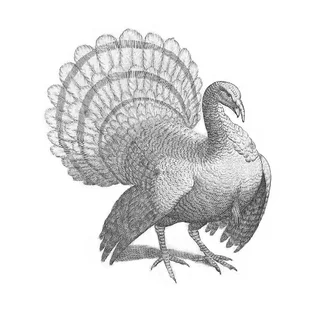Back in those old days, this was the time of the year when livestock would be moving closer to the market areas from the mountain ranges and inland ranches. Turkeys, during the first part of the century, provided a good means of support for anyone who had the desire to drive them to the market point at Korbel and transshipment to Eureka and other Humboldt County areas, and on to San Francisco.
To be sure they were fresh — they had to be alive. Abe Bush and family of Hyampom raised 550 turkeys in the year 1912 and he gathered up his flock at the end of the summer and began his drive with the help of his wife and their three children. He had a difficult time in persuading the birds to cross the river. Finally, after fussing and cussing, they flew across the South Fork at a place where the valley narrows and then they went on to Humboldt County by way of South Fork Mountain.
Travel slowed when the sun began to set; the birds roosted in the trees. At dawn they were on their way again. While in the timber, Abe cut down sugar pine trees so the birds could feed on the pine nuts.
Once over the South Fork Divide, the country opened into large meadows and the turkeys would feed on the large number of grasshoppers. Finally, when Korbel and Blue Lake were reached it was in time for Thanksgiving and Christmas. The turkeys were sold for $1.25 each. Out of the 550 turkeys, Abe lost only eight birds. That was a real feat for one man, one woman, and three young children and a couple of dogs.
At the same time, turkeys were often on the move from the Mattole Valley, using the beach road below Cape Mendocino, then up over the Cape and staying on high ground where they fed and had protection. The late George Lindley, who became a Humboldt County supervisor from District No. 1 told me that it took several days to get a head of turkeys to Ferndale and to Singley Railroad Station where they were shipped to Eureka, but the loss was usually very small. Dogs had been specially trained to handle their feathered charges (George had a number of uncomplimentary things to say about turkeys.)
Traveling turkey flocks were popular with ranchers in southern Humboldt and they began their trek in midsummer keeping on the move until time for shipment in late autumn.
One flock started from Freshwater, and had moved across Kneeland Prairie over the open ranges and through the little valleys, consuming the available grasshoppers — there were several hundred turkeys in the flock. They criss- crossed the area in their travels getting to most ranches to which they had been invited and where they would stay for several days. The family would be guests of the grateful ranchers.
By late August or September the herders would start their flock homeward and the same ranchers would let the birds fatten, gleaning the fields after the grain had been harvested. On reaching their home ranch at Freshwater the turkeys would be crated and hauled to the dock at Eureka and taken aboard a steamer for San Francisco, to become the center of attraction on the Palace Hotel’s or a family’s festive table.
###
The story above was originally printed in the November-December 1981 issue of the Humboldt Historian, a journal of the Humboldt County Historical Society. It is reprinted here with permission. The Humboldt County Historical Society is a nonprofit organization devoted to archiving, preserving and sharing Humboldt County’s rich history. You can become a member and receive a year’s worth of new issues of The Humboldt Historian at this link.

CLICK TO MANAGE